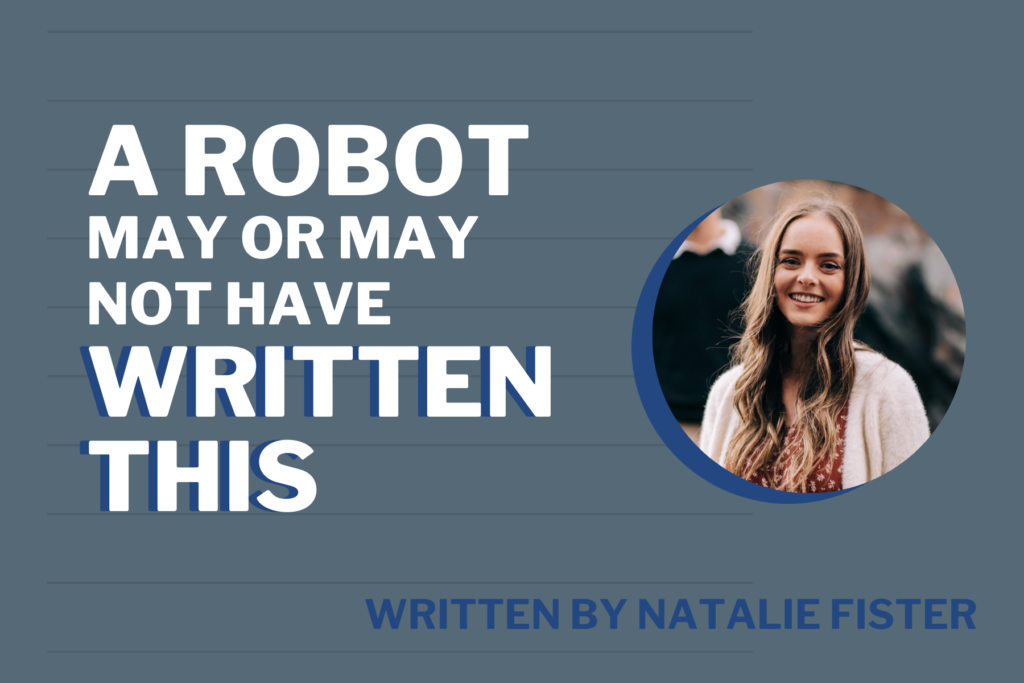A Robot May or May Not Have Written This

It took ChatGPT two entire minutes to write a two-page paper on AI’s effects on public relations. In comparison, it took me two hours to research, an hour to conduct an interview and another two hours to actually write up this same topic. While the artificial intelligence version lacked my personal charm and “human touch,” the capabilities and rapid growth of this tool are undeniable.
According to research gathered by Bojan Jovanovic at DataProt, 37% of businesses and organizations currently employ AI, and nine out of 10 leading businesses have investments in AI technologies as of this month. This trend certainly doesn’t exclude the field of PR or communications. It is widely acknowledged that the use of AI in PR is on the rise, with many organizations and PR agencies adopting AI-powered tools and technologies to enhance their operations and gain a competitive advantage.
PR professionals must prioritize AI due to its present impact on the industry and potential to greatly alter the planning, execution, and evaluation of PR campaigns. The use of such tools has proven to promote productivity and efficiency, rendering conventional PR job descriptions outdated in the near future. For better or for worse, AI is here to stay, which means PR professionals need to adapt if they want to keep up.
Background Information
McKinsey and Company predicts that while AI will impact all areas of business, marketing and sales — and by extension, PR — will be the most influenced industries. In fact, AI is projected to increase the value of marketing and sales by $2.6 trillion according to Anindita Gupta at Analytics Insight. If this payday isn’t attractive enough, AI is on track to revolutionize the way PR professionals operate on a day-to-day and long-term basis. Projected analytics, media list curation, personalized content, data gathering, sentiment analysis and crisis prediction are just a handful of monotonous, time-consuming tasks that could be completed by AI within minutes, if not seconds.
Already, AI is making its mark in PR, as numerous organizations and PR agencies implement AI-based tools and technologies to improve their performance and stay ahead of the competition. Gupta provided additional data involving a 2020 survey by the Public Relations and Communications Association (PRCA), which found that over 40% of PR professionals are already using AI and 28% plan to use it in the near future. Keep in mind, this number is likely much higher now that ChatGPT has become commonplace. As AI technology continues to advance and become more accessible, it is likely that we will see an increasing number of PR officials using it in their daily work.
Capabilities of AI in the PR world
Artificial intelligence has significantly impacted the field of PR by enabling professionals to improve their efficiency, effectiveness and accuracy. AI-powered tools can help PR professionals monitor media coverage, analyze sentiment and identify influencers, as well as assist in creating personalized messaging, identifying potential crisis situations and automating tasks like media outreach and reporting. While there may be concerns about the potential misuse of AI in PR — particularly concerning issues of privacy, bias, and ethics — the integration of AI into PR is inevitable.
“No one really publishes content on the first draft,” says Dr. Devin Knighton, BYU professor of public relations. “What AI does is speed up that first or second draft. It may not be accurate at first, but it makes the process of getting it out to our audiences much quicker.” According to Knighton, “If we’re putting in the right prompts — the write values, key messages, audiences — we can implement it in campaigns.”
As PR professionals begin to implement more AI tools in their work, it is inevitable they will research and produce more efficiently than ever before. From completing tedious work like media list compilations to complex data analysis, AI is predicted to allow professionals to devote their time to creative, persuasive projects. This shift from repetition to strategy is a game-changer in the PR world, but — as posited by Knighton — will “likely eliminate jobs” if professionals don’t keep up.
The future of AI and PR
While the increased use of AI in the field of PR is likely to have a large impact on PR jobs, it’s important to note that AI is not going to replace PR professionals altogether. If anything, PR professionals should be excited for this upcoming change, as AI will allow them to develop their skill sets and human capital. As AI becomes more prevalent in the field of PR, professionals will need to develop new skills related to data analysis, AI-powered tools and communication with AI-powered chatbots and virtual assistants. These new skills can open doors for PR professionals who might want to expand their careers in related fields, such as chatbot development or content creation with the help of AI-powered tools.
AI can certainly enhance efficiency and effectiveness, but the human touch remains crucial in PR. This sentiment is particularly applicable when it comes to relationship building and crisis management, which require empathy and emotional intelligence.
According to Knighton, “AI is a machine — it has grammar, sentence structure, information — but does it have empathy? Does it have the ability to protect and empathize? We can’t lose the humanness that is required in Public Relations.”
Yes, it is true that AI will likely revolutionize the PR world in many ways, but it is still a machine; nothing can replace the “humanness” and empathy behind a talented individual’s work. As powerful as AI may become, PR professionals shouldn’t be too worried about robot domination in the workplace. Instead, they should worry about adapting and developing their own skills.
Final thoughts
Knighton stated it well when he strongly suggested how students need to begin to push the limits of AI as soon as possible, as well as “figure out what [AI] can and can’t do, and stay clued in to what it can do in the future.” Public relations professionals and the entire workforce alike can’t possibly mitigate the revolution that is AI in the professional world, but this doesn’t need to be a scary thought.
Robots may be taking over in a sense, but they are here to help (at least for now). The more PR professionals learn about what AI can do for them rather than what AI can do to them, the more they can develop their skill sets and adapt to our ever-changing technological landscape.
Natalie Fister is a soon-to-be public relations graduate from Brigham Young University. She currently works as a marketer and communications specialist for BYU Continuing Education and advertising assistant for BYU Arts. Aside from PR and marketing, her passions surround current events, trends in the workforce and female empowerment. You can connect with her on LinkedIn.

